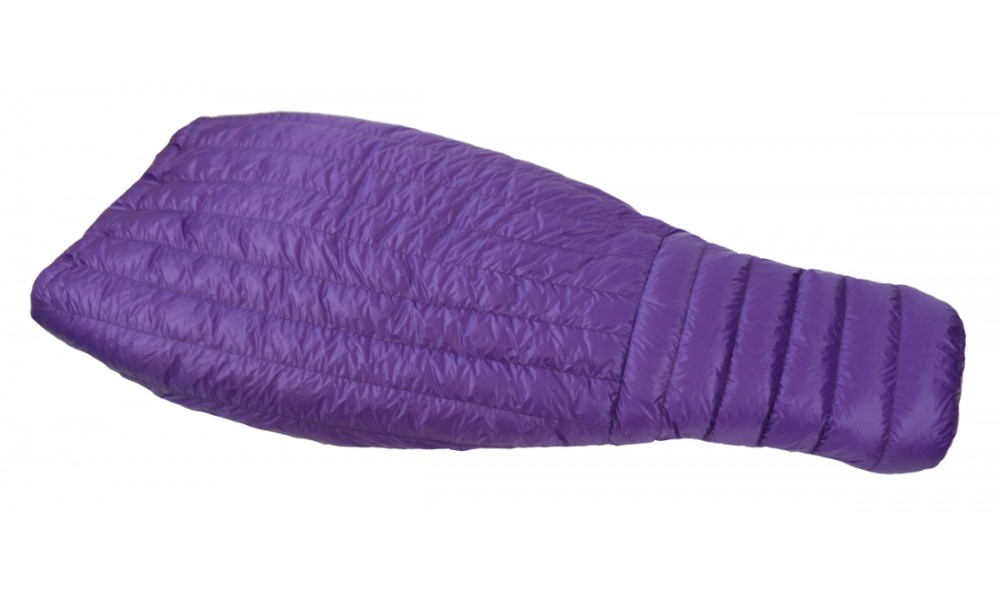You've done your homework and reached the conclusion that a quilt will suit you better than a traditional backpacker's mummy sleeping bag. But there are many quilt models, temperature ratings, features, and, on top of that, sizing issues. Where to start? Let's step back and first look at the models we carry.
Nunatak has 2 principal lines of backcountry down quilts: The Arc UL and the 3D Quilt.
In short the Arc UL is lighter and firmly rooted in the classic quilt idiom.
The 3D Quilt is built like a cross over quilt/mummy bag with every detail optimized to provide the warmest option for shoulder season or consistent cold weather use.
We also make specialized quilts for various purposes
By far the most popular quilt is the Arc UL. Let's base some important user considerations on that choice.
Temperature. You can get the Arc UL in five degree steps from 15° to 30° Fahrenheit. The most often asked question is: How warm should I go?
When it's 15°F at night, it's really cold! This is near or maybe even below the threshold for effective quilt use. If you go here, make sure you got your back covered, literally!
30°F is a typical summer night-time temperature met in the mountains of the lower 48 states and the European and New Zealand Alps. A quilt made for 30° is the experienced hiker's opportunity to save weight and bulk.
In between these two is are the 20°F and 25°F.
A 20° quilt is warm enough for October trips up high, or freak cold fronts. It will protect a beginner or timid hiker with an extra buffer of insulation. Good for so-called cold sleepers. When in doubt, 20°F is for you.
The 25°F is the all-rounder, equally at home on the trails as in the exposed high country.
Does the temperature rating of our quilts reflect a state of 'comfort' or mere 'survival'? How do we define the conditions to which our quilts can be taken before they start feeling cold? Like this:
An average male backpacker will be comfortable in a Nunatak quilt at the given rating if...
..he's on an insulated pad matching the conditions.
..he's inside a tent, with walls reaching the ground and a closable entry.
..he's wearing long johns, a thermal zip neck, socks and head gear.
..he's well fed and hydrated.
These conditions can adversely affect this backpacker's comfort:
First time quilt user unsure how to get the most out of the features.
Recent significant gain in camping altitude; anxiety, fear; illness.
Sleeping under the stars, aka Cowboy Camping.
Moisture infiltration in the down insulation.
Please note that the use of a male in these examples is because women often report a increased sensitivity to the effects of cold nights. For many females the 20° quilt, for example, will have a higher likelihood of failing before the temps actually dips to 20°.
Next up in important choices are overall length and width of the Arc UL down quilt. The numbers in inches mentioned here and on the products pages are true, useful measurements.
Adequate coverage is absolutely key to quilt performance. But too much will result in unnecessary weight and bulk, bringing the weight closer to the generic mummy bag.
First length. The choices given on the menu pages are inside useable measurements. Select a length that at least allows the quilt to cinch down over the shoulders. We consider this is a minimum, applicable to seasoned users. More comfort oriented hikers prefer longer than that.
Stomach sleepers usually curl up when it gets cold. However, it might be best to size up four inches if this is your preferred position.
The correct width of the quilt is very important. If the quilt is too narrow it can be hard to eliminate drafts and accidental uncovering, resulting in a highly unsatisfactory experience.
Like length, width is dictated by body size. But additionally sleeping behavior and positions plays a big role here. Larger builds, folks that toss and turn, and maybe side sleepers, should all consider a wider quilt.
The temperature rating can also have a bearing on which width to choose. During milder conditions it is less critical to have a super effective seal, while a deep winter quilt must work as designed.
For the Arc UL we have four width sizes:
50": Good coverage for slim builds. Adequate draft control. Well suited for moderate temperatures; and/or experienced quilt users in all conditions.
56": Most popular. Easy draft control. Less fiddling when turning over. Ideal coverage for average sized people. Similar to the 'wide' designation in some competing brands.
62": Very good coverage for bigger people or active sleepers who wants a 'set-and-forget' style quilt.
68": Super large quilt with absolute sprawling coverage.
Finally the footbox can be individually sized. We feel a slightly oversized foot compartment is the most thermally effective. Having toes poke through the down will surely lead to cold feet, more than a larger dead air space to warm up. The latter is greatly diminished by modern ultralight fabrics that drape readily.
Again, sleep patterns can affect choices. A dedicated side sleeper/stomach sleeper with large feet may get away with a smaller footbox. On your back all the time? Go large for the sake of warm toes.


I am 5 foot 9 200 pounds lookimg for a quilt for trails like the jmt in sept so needs to be pretty warm.What do u suggest and why?
I am 5’ 10” 150 lbs and a cold sleeper. I sleep on my side what’s a good fit?